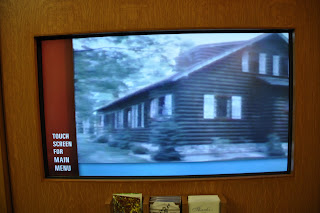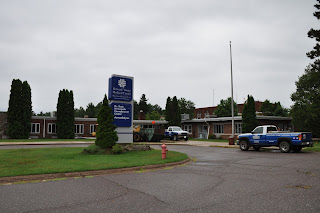A view of Hollywood looking over the Hollywood Bowl.
Since the early 1920s, residents of the Hollywood area have been gathering at The Hollywood Bowl to listen to music outside, under the stars. The "Bowl," a natural amphitheater carved into a hillside in the Hollywood Hills, is the home of the Hollywood Bowl orchestra, the summer home of the Los Angeles Philharmonic, and the setting for so many other outdoor musical events, such as The Sound of Music Sing-a-long, the Playboy Jazz Festival and many pop concerts.
An early postcard view of the Hollywood Bowl
Like so many other Angelenos, for me, attending the Hollywood Bowl is developing into an annual summer time experience, although I'm still learning some of the tricks to make the most out of a Hollywood Bowl show. Some attendees arrive to the Bowl early bringing a full picnic spread which they lay out in one of the tree covered spots on the Hollywood Bowl grounds. Attendees come with packed coolers and picnic baskets filled with their favorite libations and yummy bites. The grounds surrounding the bowl feel very woodsy, almost like being on planet Endor, you know, where the Ewoks live in Star Wars? It feels like an escape from the city and the perfect getaway for a picnic. (Excuse me while I slide my glasses up my nose after making that nerdy comparison). If you don't bring your own picnic basket, the Hollywood Bowl does sell picnic baskets which you can order.
By the way, if you visit the Hollywood Bowl, it is worth taking the time to look at "The Bowl Walk" exhibit. There are ten stations around the Hollywood Bowl park area displaying images and information on the cultural events and history of the Bowl.
Easter Service at the Hollywood Bowl 1920s
The iconic looking bandshell where the orchestra performs wasn't constructed when the Hollywood Bowl first opened to entertain guests. In 1922, the Bowl only had a simple awning covering the stage and makeshift wooden benches for the audience to sit. Above is one of my postcards showing the Hollywood Bowl during a special Easter service without the bandshell in the background. Below is another of my postcards showing an Easter service, but a few years later with a bandshell.
A later view of the Bowl hosting an Easter service.
There have been several different shells at the Hollywood Bowl. The first shell was built in 1926. At that time the grounds were regraded and the wooden benches were replaced by permanent seating. Although the upgrades to the Bowl provided more seating, the acoustics were diminished by the regrading. Lloyd Wright, the son of Frank Lloyd Wright, was hired to build a new shell. Wright had previously built sets at the Bowl for various theatrical productions and for the shell he designed for the 1927 season, he recycled wood from a Robin Hood set to build a pyramid structure that was supposed to improve the acoustics and complement the rustic setting. Wright's shell was demolished at the end of the 1927 season and in 1928 Wright was hired again to design a second shell. Wright's second shell had a more modern design popular during the time period, however, like Wright's previous shell, his second would also be demolished at the end of the year.
Vintage postcard image of the Hollywood Bowl.
There would be several different versions of the shell at the Hollywood Bowl. The current shell, built in 2004, incorporates elements from some of the previous shells but also integrates the latest state-of-the-art lighting and sound technology.
Looking east across the Hollywood Bowl.
THE HOLLYWOOD BOWL IN THE MOVIES
Several classic films have featured The Hollywood Bowl as a location including A Star is Born (1937), Champagne For Caesar (1956), Hollywood or Bust (1956), Moonlight Murder (1936), and Two On A Guillotine (1965) to name a few. My favorite films that feature the Hollywood Bowl are two classics from the 1940s: Anchors Aweigh (1945) starring Frank Sinatra and Gene Kelly and It's A Great Feeling (1949) starring Doris Day, Jack Carson, and Dennis Morgan. Below are some screenshots of the Bowl from Anchors Aweigh and It's A Great Feeling.
Frank Sinatra and Gene Kelly try to get into the
Hollywood Bowl in Anchors Aweigh (1945).
Sinatra and Kelly sneak into the Bowl by
climbing up the back hillside.
Kelly and Sinatra looking down at The Hollywood Bowl.
The entrance to The Hollywood Bowl as seen in the
film It's A Great Feeling (1949).
Dennis Morgan and Jack Carson both try to win
over Doris Day at the Bowl in It's A Great Feeling.
Morgan, Day, and Carson watching a show at the Bowl.
Wifey and Robby at the Bowl for
the Playboy Jazz Festival.
Fantasia at the Hollywood Bowl
Fireworks during Fantasia at the Hollywood Bowl.
Summer is coming to an end, although, it certainly doesn't feel like it will be over anytime soon with how hot it is currently in Los Angeles, but there is still another month of performances at the Bowl. Visit the official Hollywood Bowl website to view the calendar of events by clicking here.
Do you have any fond memories or experiences from visiting The Hollywood Bowl? Do you have any tricks or tips to share for visitors?































































